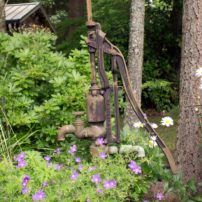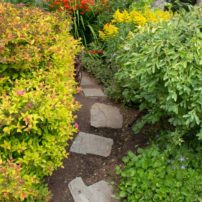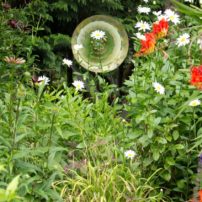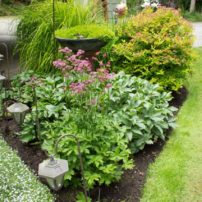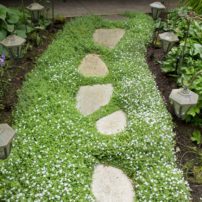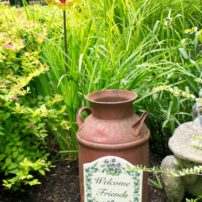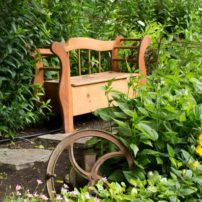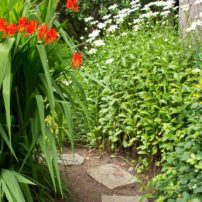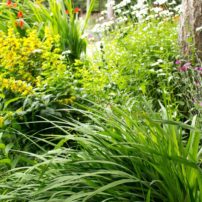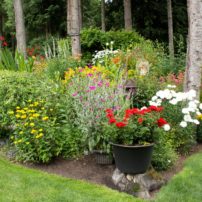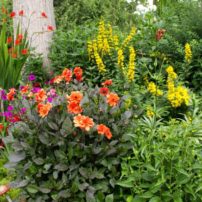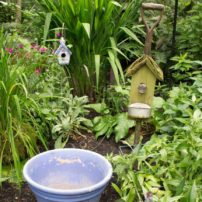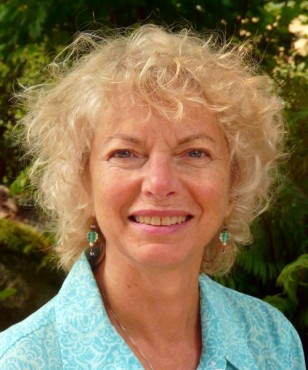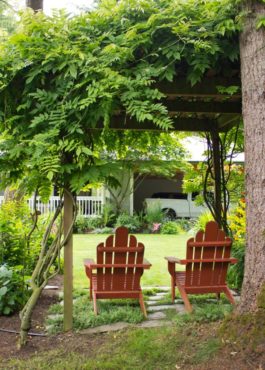 “We kind of built this whole place around the grandkids,” said Sam Johnson, speaking about the 30 acres of mostly forested land near Kingston that he and his wife, Debi, purchased in 2001.
“We kind of built this whole place around the grandkids,” said Sam Johnson, speaking about the 30 acres of mostly forested land near Kingston that he and his wife, Debi, purchased in 2001.
The Johnsons had been living in Edmonds and were both getting ready to retire from the construction business. They wanted a place their 11 grandchildren would enjoy.
“We were looking for space,” Johnson said. “We didn’t want a gym membership. We wanted a project.”
And a project they got! “We do one hundred percent of the work ourselves,” he said. That includes construction, forestry and gardening.
The woods had once been Pope and Talbot timberland. The land included an unfinished box of a house sitting in a muddy, bulldozed clearing at the end of the road. The builder of the house had owned the property for only a year when the economy tanked in 2001. There weren’t even steps up to the front door.
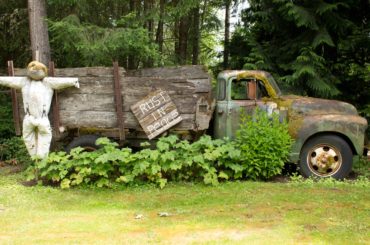 With help from their son, Johnson gutted the existing structure down to just roof, siding and windows. Then they built “a Grandma-Grandpa house” where the grandchildren from the city could “play and be free,” he said.
With help from their son, Johnson gutted the existing structure down to just roof, siding and windows. Then they built “a Grandma-Grandpa house” where the grandchildren from the city could “play and be free,” he said.
“We wanted them to be off the Gameboys and computers and be outside,” he said. “So we built the log cabin, the bunkhouse, the pool, the trails, the yard, the deck, the carport, the swings.” The carport is big enough to double as a covered sports court.
On rainy days, the grandkids rode their tricycles, bikes and scooters around on the covered, extra-wide, wrap-around, porch-like deck. The 12-by-14-foot log cabin was a summer project Johnson and two of his grandsons built together when the boys were 6 and 10 years old.
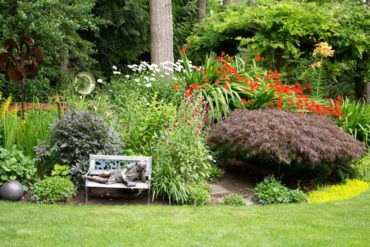 “We felled the trees and they peeled them and notched them,” he said.
“We felled the trees and they peeled them and notched them,” he said.
Throughout the property — in the forest, the house and the gardens — one finds evidence of the importance of family, heritage and posterity. It can be seen in everything from the decision to preserve natural habitat by participating in the state’s Forest Stewardship Program, to the grandson’s little hiking boot planted in Debi’s diminutive “fairy garden.”
Forest Stewardship is a nationwide program that provides advice and assistance to help family forest owners manage their lands. It’s a cooperative program between the U.S. Forest Service and state agencies. In Washington, the state Department of Natural Resources Small Forest Landowner Office (SFLO) administers the program.
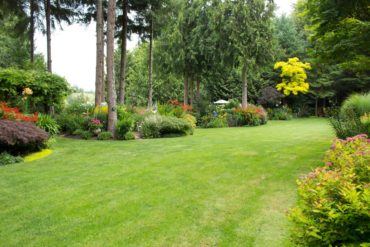 “My forestry program requires me to increase fire access; build trails; increase wildlife habitat; and harvest, thin and replant trees,” Johnson said. “And that’s what we wanted to do with the property. We wanted to increase habitat and have trails for the kids.”
“My forestry program requires me to increase fire access; build trails; increase wildlife habitat; and harvest, thin and replant trees,” Johnson said. “And that’s what we wanted to do with the property. We wanted to increase habitat and have trails for the kids.”
He estimates that each year, they remove about 100 trees and plant about 250. The stewardship program also has some property tax advantages. And the trees provide fuel to heat the house and the water heater.
With all that wildlife habitat, the Johnsons often see black bear. Cougar are seen less often but they leave their tracks. As a result, the deer population is kept in check and deer rarely munch in the garden.
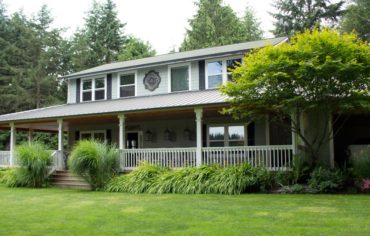 The bear, however, had been raiding the bird feeders until Johnson came up with a solution.
The bear, however, had been raiding the bird feeders until Johnson came up with a solution.
“I built a big one that the bear can’t tear down,” he said. “I put it on ‘schedule 80’ pipe so it’s extra strong, and I made it so when the bear pushes on it, it spins and rings a big old cow bell we hung on the bottom.”
When one comments that Johnson is very handy, his wife replies with a big smile, “Oh, yes. Just about the most handy man you could want. I point to it and he does it.” She adds with a laugh, “I tell him, ‘I just have this vision.'”
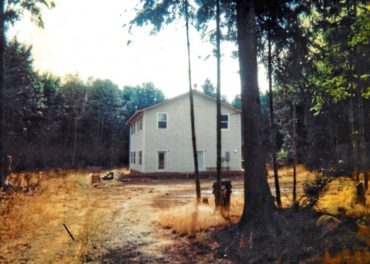
Part of her vision was for lots of flowers. During all their years in Edmonds, neither one had ever done any gardening. Construction season conflicts with gardening season. After a laughable first experience with a bag of gladiolus — “I didn’t even know which way they went,” she said — the garden grew piece by piece, bed by bed. She would say to her husband, “Would you throw me a mound of dirt there” or “Would you build me a little arbor there.” “It just kind of kept unfolding,” Debi Johnson said. “Now we can go pick bouquets like crazy.”
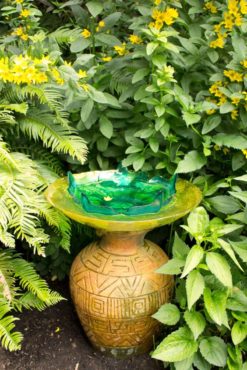 By midsummer, hydrangeas, hardy fuchsias and hostas light up shady areas. In sunnier beds, Crocosmia ‘Lucifer,’ a rainbow of dahlias, majestically tall lilies, cone flowers, spiraea, shasta daisies and many other flowers bloom. Tall spikes of bright-yellow loosestrife are stunning combined with red crocosmia and dark-leaved, orange dahlias, but Debi Johnson warns that the loosestrife spreads vigorously.
By midsummer, hydrangeas, hardy fuchsias and hostas light up shady areas. In sunnier beds, Crocosmia ‘Lucifer,’ a rainbow of dahlias, majestically tall lilies, cone flowers, spiraea, shasta daisies and many other flowers bloom. Tall spikes of bright-yellow loosestrife are stunning combined with red crocosmia and dark-leaved, orange dahlias, but Debi Johnson warns that the loosestrife spreads vigorously.
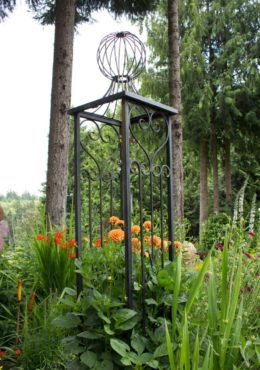 She said that although she didn’t deliberately choose plants to attract wildlife, “the butterflies, the birds, the hummingbirds — they’re crazy in the yard in the summertime.”
She said that although she didn’t deliberately choose plants to attract wildlife, “the butterflies, the birds, the hummingbirds — they’re crazy in the yard in the summertime.”
They currently have about an acre and a half landscaped. A wide sweep of lawn borders the home and its deep, gracious porch. A meandering chain of garden vignettes, like a necklace of gems, forms a soft border between the lawn and the forest beyond.
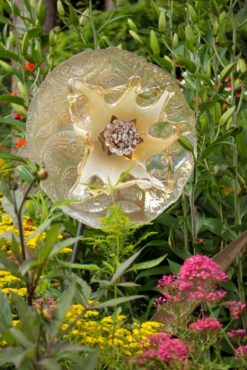 Some vignettes open into small garden rooms that invite one to enter, sit and rest — a pair of Adirondack chairs under an arbor or a small bistro table with umbrella and chairs in a hidden alcove. Many of the vignettes include garden art and family treasures. As the grandchildren grew, their childhood playthings sometimes became part of the gardens. “It’s a memory,” Debi Johnson said.
Some vignettes open into small garden rooms that invite one to enter, sit and rest — a pair of Adirondack chairs under an arbor or a small bistro table with umbrella and chairs in a hidden alcove. Many of the vignettes include garden art and family treasures. As the grandchildren grew, their childhood playthings sometimes became part of the gardens. “It’s a memory,” Debi Johnson said.
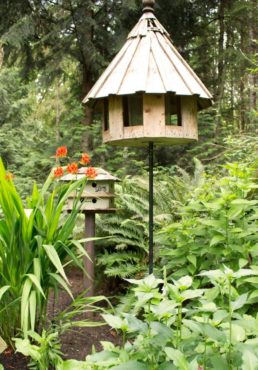 In one vignette, on a low mound in a niche between three tall conifer trunks, a red tricycle sits among sword ferns at the base of a bird feeder. The feeder looks like an open-sided picnic structure with a rustic, plank roof. A weather vane tops it. No longer used as a bird feeder, it now houses a grandfather’s old work boot, resting toes up.
In one vignette, on a low mound in a niche between three tall conifer trunks, a red tricycle sits among sword ferns at the base of a bird feeder. The feeder looks like an open-sided picnic structure with a rustic, plank roof. A weather vane tops it. No longer used as a bird feeder, it now houses a grandfather’s old work boot, resting toes up.
Sam Johnson converted another old boot into a birdhouse and hung it on a tree stump. That boot was given to the Johnsons by a family friend when he retired from logging.
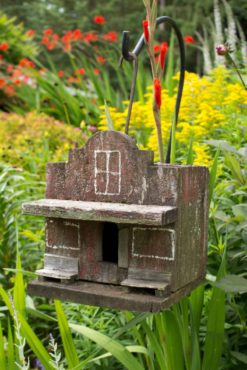 Birdhouses and bird feeders are scattered throughout the gardens, each different. One looks like a rustic, Old-West storefront, with two tiny benches on a porch. Another resembles a gazebo with a round, pointed roof. Debi Johnson found a few of them here and there but most of them, her husband built.
Birdhouses and bird feeders are scattered throughout the gardens, each different. One looks like a rustic, Old-West storefront, with two tiny benches on a porch. Another resembles a gazebo with a round, pointed roof. Debi Johnson found a few of them here and there but most of them, her husband built.
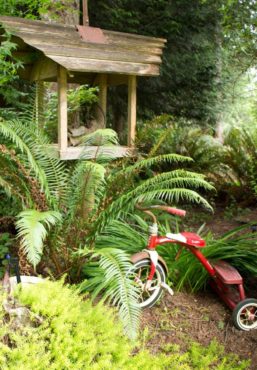 Other family memories tucked into the gardens include an antique cultivator, some old-fashioned hand pumps and an old wheelbarrow. A child’s wagon spills over with flowers in summer.
Other family memories tucked into the gardens include an antique cultivator, some old-fashioned hand pumps and an old wheelbarrow. A child’s wagon spills over with flowers in summer.
The painted sculpture of the face of a wood nymph, mounted on a deeply grooved tree trunk, holds special meaning. “It’s our very favorite piece,” Debi said. “We call it the Garden Angel. It was a gift from a grandson when he was about 7 years old.”
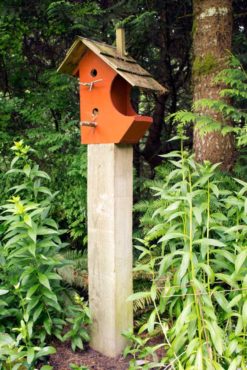 Among many fun pieces of garden art are beautiful glass “flowers” on tall metal stems. These are another team project. She collects unusual pieces of glassware, drills holes and designs how they will fit together. He does the ironwork and assembles them with his weatherproof method.
Among many fun pieces of garden art are beautiful glass “flowers” on tall metal stems. These are another team project. She collects unusual pieces of glassware, drills holes and designs how they will fit together. He does the ironwork and assembles them with his weatherproof method.
Another of her visions was the swings. “I asked Sam to build me a swing but not just any swing,” she said. “This is what he came up with. I mean, it’s huge.”
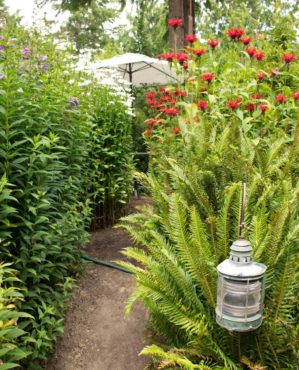 In a grassy clearing in the woods, reached by passing under an arbor, three swings hang on long, thick ropes from a very tall frame of sturdy steel pipe. The scene feels a bit like a secret hideaway.
In a grassy clearing in the woods, reached by passing under an arbor, three swings hang on long, thick ropes from a very tall frame of sturdy steel pipe. The scene feels a bit like a secret hideaway.
The Johnsons still do all of the work on the property themselves — completing art and construction projects, gardening, felling trees, cutting logs for firewood and tending their 30-or-so chickens.
“We so enjoy working together. The other day, we took down three diseased, big fir trees right here in the flower beds,” Sam Johnson said.
His wife added, “They didn’t even hurt a flower — and they had to come across the garden. It was amazing.”
Lately, however, he has begun to complain, with humor, that he’s getting too old for her “visions.” “I call ’em nightmares now,” he jokingly said. Still, they have no plans to scale back yet.
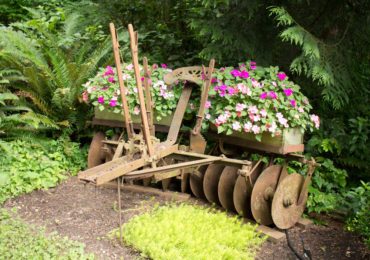 With the grandchildren grown up and busy with sports and life, Grandma and Grandpa are looking forward to the next generation of little feet running around the deck and down forest trails.
With the grandchildren grown up and busy with sports and life, Grandma and Grandpa are looking forward to the next generation of little feet running around the deck and down forest trails.
But first, Debi Johnson has one more special vision — to see a bride in her wedding dress on a swing.
“That’s always been my vision,” she said.
Indeed, their garden would be a glorious setting for family weddings.




